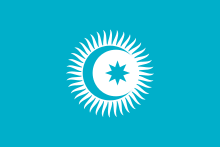Simjurids
The Simjurids were a Turkic family that served the Samanid emirs (also transliterated as amirs, aamirs or ameers) of Bukhara in the 10th century. They played an influential role in the history of eastern Iran and southern Afghanistan during that time, and by the second half of the 10th century they had built a semi-independent principality in Khurasan.
History
The Simjurids originated as Turkic slaves (mameluks or ghilman) for the Samanid amirs.[4] They quickly rose to prominence thanks to their skills as military commanders and governors, along with their extensive estates in the Quhistan region which acted as a permanent power base.[5]
Their founder and eponym, Simjur al-Dawati, was appointed to various governorships in eastern and central Iran, and helped the Samanids to expand their authority in that region. His son Ibrahim ibn Simjur was appointed as governor of Khurasan in 944/945, but only held it for a short time. After Ibrahim's death, his son Abu'l-Hasan Simjuri was invested with the governorship of Khurasan and served in that position for almost three decades.[5]
With the ascension of the child Nuh ibn Mansur to the Samanid amirate, Muhammad was able to gain greater autonomy from Bukhara for himself. He was a key figure in the struggles that wracked the Samanid state in the 970s and 980s. When he died, his son Abu Ali Simjuri took his father's place. Abu 'Ali completely renounced the sovereignty of the Samanids and was able to resist his enemies for some time, but was ultimately captured and executed by the Ghaznavids, another Turkish slave family, who then took over Khurasan.[5]
List of Simjurids
- Simjur al-Dawati, (913-914)
- Ibrahim ibn Simjur, governorship (945-946)
- Abu'l-Hasan Simjuri, 1st governorship (956-960), 2nd governorship (961-982)
- Abu Ali Simjuri, I 1st governorship (984-987), 2nd governorship (995-997)
See also
- Turkic peoples
- Timeline of Turks (500-1300)
- List of Turkic dynasties and countries
- Samanids
- Ghaznavids
Notes
References
- Bosworth, Clifford Edmund. The New Islamic Dynasties: A Chronological and Genealogical Manual. Great Britain: Columbia University Press, 1996. ISBN 0-231-10714-5
- Treadwell, Luke. "Simjurids." Encyclopaedia Iranica. Ed. Ehsan Yarshater. Columbia University. Retrieved 8 May 2012.
